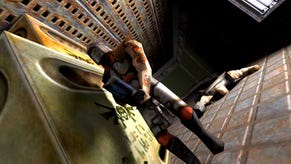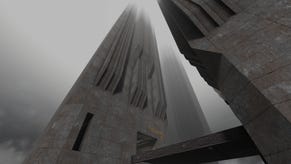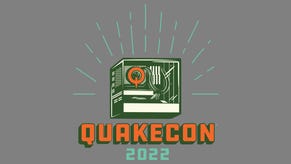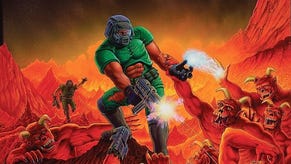Quake On Oculus Rift Is Magnificent
1996 virtual reality, today
Resolution. Anti-aliasing. Crisp text. "Image quality." The bugbears of virtual reality in 2016.
All of this matters not in Quake. Perfect square pixels, no shading or soft shadows. Almost wordless. It is ideally-suited to VR, in theory. In practice? Best VR time ever, so far.
One proviso, which I'll get out the way up front: I am experiencing no small amount of motion sickness in almost everything I play on my recently-arrived Oculus Rift. Case in point: even though Quake on the Rift made me giddy with happiness, it also made me giddy with nausea. More so than most other stuff, because it's so bloody, beautifully fast. I should note that motion sickness has not been the case for anything I've played on the Vive, which I've had for a couple of months now, and I cannot for the life of me ascertain what the difference is, given they share the same resolution and refresh rate. Annoying and confusing, but until I track down an exact cause and possible solution, I guess I'll be spending more time with the Vive. Which means not much more Quake VR just yet.
Quake VR is a modification of Quakespasm, an OpenGL (i.e. fully 3D-accelerated) variant of the original game which adds basic, careful extra prettiness without deducting any authentic Quakiness. It looks like Quake as you remember it, basically, i.e. awesome. Doubly so in the humongo-world of VR. It's a fairly basic port, but it works well - even down to the UI (health, ammo etc) hovering on the gun, so you can gaze down at it rather than have it perpetually stamped on the bottom of the screen. The weapon position being attached to wherever your head turns feels pretty damn off, but you can change that in settings, so the gun stays still and you can look around independently.
Mostly, though, it's Quake In The Flesh. Enemies are man-sized (or more). The fortress/spaceship mash-up design feels solidly there. Running right up close to a foe is genuinely frightening, those ancient textures somehow making them more monstrous than pin-sharp modernity might. I think that's why I've been so amazed by Quake in VR: I accept, right out the gates, that there's no way it can look like real life, and that means I embrace it entirely as an alternate reality rather than worry that this or that doesn't look photoreal enough. Also, it's a chance to revisit images burned into my memory in a whole new way.
Living inside Quake, it becomes a sightseeing game as well as an action game, but of course, being Quake, you get little let up. I find myself gritting my teeth in this as I did 20 years ago, because the enemies feel so there. God, a dog lunging towards me is perfectly horrific. Quake! It's dark and forlorn and otherwordly and, yes, scary.
I admit, it's basically what we thought VR was going to be in 1996, and it's a crying shame that it's taken us 20 years to get there. Naturally, old Quake doesn't give my GPU too much of a fright even in VR, so it benefits from an "it just works" element that some actual 2016 vr fare doesn't. The key is stylisation, though; not necessarily deliberate at the time, but like its predecessor Doom, Quake's look has become distinctively its own, iconic and striking rather than simply aged.
Sigh. I am trying to describe the indescribable. I've had a rocky relationship with VR in recent months - reaching a zenith of excitement just before my Vive arrived then collapsing into a deep disappointment when I could find very little (Tiltbrush aside) software to hold my attention for long, and at how much image quality compromise there had been in order to keep things playable on current-gen PCs. The Rift has reinvigorated me to some extent, because it means I don't hang any hats on the room-scale side of things, and also because there's a little more in the way of modification of non-VR software for it, partly due to the run up the two devkits and a couple of years of development offered it.
American Truck Simulator, for instance, has easy Rift support but, last time I tried at least, the Vive version wasn't anything like so happy. Clearly though, the Vive will end up with plenty more stuff in time, and the Revive project is also helping to get Oculus-specific stuff working on the HTC headset. Ultimately it won't matter which headset you've got.
In any case: Quake in VR, as ancient as it is, makes me feel excited about the technology again. Fast, first-person action games with full controls do work, presuming you're familiar enough with your mouse and keyboard to effectively use them blind, and maybe some more developers will embrace that instead of overly worrying about simpler controls. That'd be good. That'd be great.
Quake VR - or Quakespasm Rift to give it its proper name - is a free download, but you will need the .PAK files from a full copy of Quake if you want to play anything other than the shareware chapter. You can grab that from Steam for the price of a beer, though.










